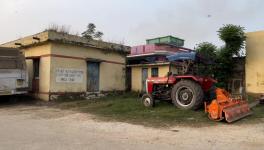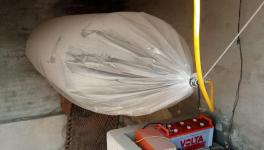Did We Learn Any Lesson from Karachi Airport Fiasco?
The audacity of last Sunday’s brazen attack over Karachi Airport that claimed over two dozen innocent lives and turned parts of a cargo terminal to ashes, raises many questions for the people at the helm of affairs.
The most sensitive area of Karachi Airport is the restricted airside stretching over 1,700 acres with 14.6 kilometers of perimeter. Heavily fortified, this perimeter is constantly patrolled by Airport Security Force (ASF) vehicles laden with well armed personnel. Amply lit fence with security posts every 300 meters straddle three sides of the airside.
Runway 07L/25R lie north of the airport within 200 meters of the perimeter fence. Densely populated Gulistan Johar, Pehlwan Goth and Bhitiabad dot the other side of this fence.
If, like the attackers, planners of the Sunday mayhem were also outsiders – Uzbek or foreign Talibans – they should not have shown the ingenuity demonstrated in planning the attack. As laymen, they would have tried to infiltrate through the apparently wide open perimeter fences, taxiway connecting general aviation area, VVIP gate near old terminal or some other access point that can be easily scaled or rammed through.
However most aircraft-bays and other essential aviation services are located at least a kilometer inside the perimeter fences with flat land in between! The planners were obviously aware that any attempt to enter from these sides would be met with massive and lethal force.
They also appear to be aware of the fact that the entrances to the PIA engineering opposite PIA Head office commonly known as ‘Fokker Gate’ and the Customs ‘Immediate Clearance Group’ (ICG), i.e., facility for perishable and other goods requiring immediate clearance located in old Terminal-3, were both manned by lightly armed ASF foot-soldiers, with no picket or barricades on the apron side.
Fokker Gate is used to facilitate PIA engineering staff moving in & out of their hangar and if required onto the apron. This gate was normally manned by two ASF guards. Once inside there was an X-ray scanner also manned by ASF after which there is another grill-gate that normally remained open though manned by an armed ASF guard.
According to the eyewitnesses, as the Sunday’s night shift started there was only one guard outside the Fokker Gate and two guards doing their routine over the scanner. Terrorists dressed in ASF uniforms coming from the Pehlwan Goth side effortlessly gunned down the guard outside and the two present at the scanner. But the ASF man behind the grill returned fire and stood his ground against the heavily armed militants but he too finally lost his life.
However this unexpected resistance alerted the ASF personnel patrolling the apron who rushed to the spot and held-up militants inside the hangar, still on their killing rampage.
If they had been able to come out of the hangar, less then 300 meters on the left sits PIA’s wide-body ‘Ispahani Hangar’ while on the right less then 200 meters away was the most crucial asset of any airport, the Air Traffic Control Tower and aircraft night parking area.
First 30 minutes were the most difficult, as there was complete pandemonium with ASF men reacting purely on their instincts. Soon ASF was joined by contingents of Police and Rangers, and later by army units. Even on their own, ASF personnel stopped the terrorists from coming out into the apron. All five militants that entered through the Fokker Gate were finally killed inside the maintenance area itself.
Meanwhile the second batch of terrorists had struck the ICG gate. They resorted to indiscriminate firing as soon as they jumped out of their van. The lone & unarmed Customs guard ran to save his life along with everyone else present there. Inside the ICG two unsuspecting ASF guards were quickly mowed down but the third one positioned behind the wooden post fought back. According to the witnesses, he died fighting till his last bullet against overwhelming fire power. His unfortunate death allowed the terrorists to spill-over to the apron near night parking area.
However as the terrorists came out of ICG they met stiff ASF resistance, forcing them to seek cover behind the cargo pallets. The ASF barrage finally forced them to withdraw inside the cargo sheds housing SAPS, Gerry’s Dnata, Royal Air and other private operators. They killed several civilians and fired indiscriminately at aircraft grounded for maintenance, damaging at least one Boeing 747 and an Airbus-310, finally losing their own lives to a determined and overwhelming number of security personnel.
If the terrorists coming out of ICG had turned right, the jet-fuel storage facility was situated barely 150 meters away. A hit on those highly inflammable jet-fuel tanks would have wrecked havoc at the airport.
The difference between the meticulous planning and poor execution by Uzbeks and Talibans, clearly demonstrates the difference between the ‘planners’ and the ‘attackers’. The planners definitely had experience and clear understanding of the airport, while the foot-soldiers had little understanding of critical aviation assets or the Karachi Airport itself.
On Tuesday there was another brief ‘hit and run’ attack over ASF Camp near Pehalwan Goth. The attackers swiftly melted away in adjoining neighborhoods.
No doubt there has been a security lapse and holes are still visible in the airport security blanket. Worst, the airport security still suffers from jurisdiction issues.
But let us rewind to 6th November 2012.
Rangers raided Ashraf ul Madaris (an outfit running a number of madrassas identified with Deobandi-Takfiri militants: Newsclick), less then a kilometer from ASF camp. According to the rumor mills, on an inside tip, Rangers came looking for a ‘high value militant’ of Tehrik-i-Taliban Pakistan (TTP) from Swat visiting Maulana Hakim Akhtar. However, during the ensuing exchange of fire, and commotion, the militant slipped away.
Less then 36 hours later a powerful bomb ripped through the Rangers compound in North Nazimabad. Naeem Bokhari group of Lashkar-e-Jhungvi swiftly claimed responsibility for that attack. LeJ is known for its close contacts with Islamic Movement of Uzbekistan, TTP and Al Qaeda; Ashraf ul Madaris alone has more the 22 establishments in Sindh.
Attackers of Karachi Airport may have been killed but the actual planners remain at large, possibly still functioning at Karachi Airport. May be we should ask ourselves, is it possible to abandon the notion of bad and good, when it comes to militants and their sympathizers?
The Author is a former administrator of Karachi City, with many years of experience flying helicopters & airplanes out of Karachi Airport.
Courtesy:dawn.com
Disclaimer: The views expressed here are the author's personal views, and do not necessarily represent the views of Newsclick.
Get the latest reports & analysis with people's perspective on Protests, movements & deep analytical videos, discussions of the current affairs in your Telegram app. Subscribe to NewsClick's Telegram channel & get Real-Time updates on stories, as they get published on our website.
























